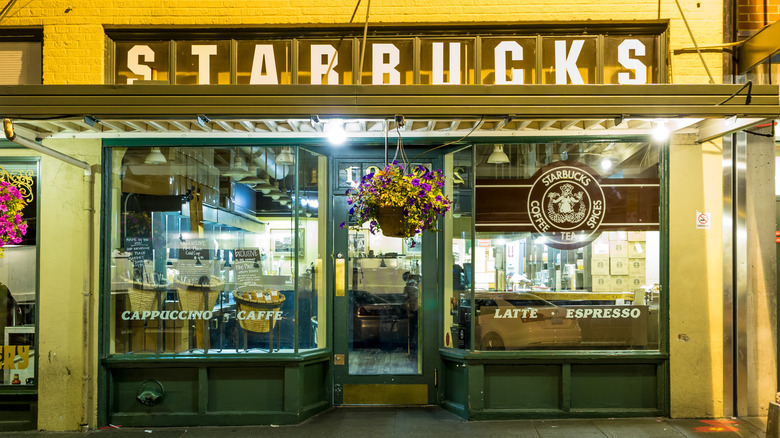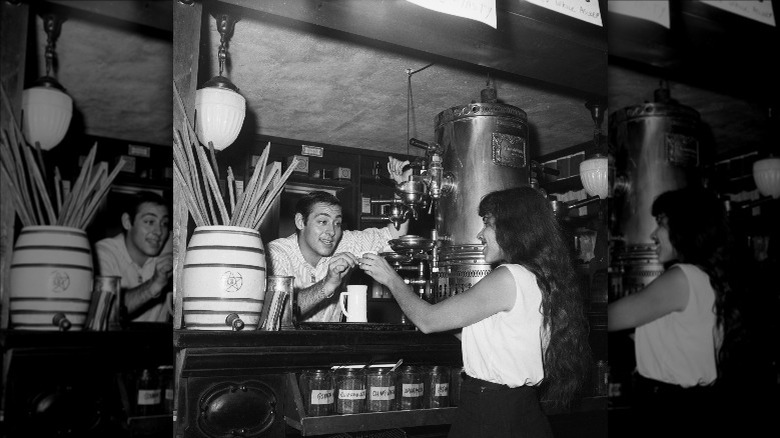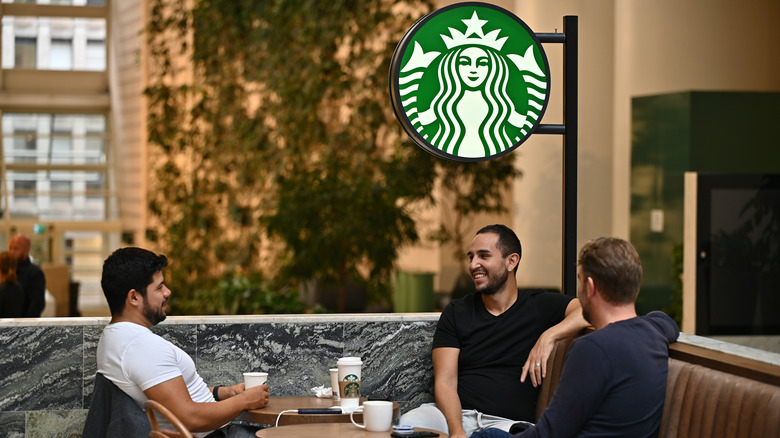Why Starbucks Looked Completely Different In The 70s
While Starbucks itself often calls back to its Pike Place origins in its marketing, even the most zealous Starbucks aficionado would hardly recognize the original Starbucks locations in its first decade of business. Walking into a pre-1980s Starbucks, you wouldn't find a single espresso machine, Frappuccino blender, or green apron — some of the company's most brand-defining characteristics. Instead, you'd be greeted by shelves of bagged coffee beans, tea, and spices ready for purchase, because, as CNBC recalls in a history of the company's rise, the original Starbucks didn't serve brewed coffee at all. Now the most internationally recognizable coffeehouse chain, Starbucks spent its first decade as more of a coffee roastery brand than anything else.
The global coffee titan only opened its first café in 1982; but even then, it was more of an afterthought that accompanied its main business of selling roasted beans by the bag. It wouldn't be until Howard Schultz took control of the company in the late '80s that its focus on serving coffee began, marking almost two decades of its 50-year history as a completely different era. Starbucks in the '70s just wasn't where you went to grab a cup of coffee; it was your weekly stop for a fresh bag of beans to brew at home during a time when café culture as we know it wasn't really a thing in the U.S.
American coffee culture in the 70's
That's not to say that cafés simply didn't exist in America at the time. According to Nancy Groce (via Library of Congress), a noted American folklorist, Italian-style cafés existed in the Italian-American neighborhoods of major cities like New York, Boston, and San Francisco as early as 1942. However, it's undeniable that coffee bars were still niche interests within specific communities and subcultures. Up until the '70s and '80s, coffee was overwhelmingly considered just another beverage, like soda. With the massive growth of instant coffee companies like Maxwell and Nescafe during World War II, as well as their post-war marketing strategies, coffee took on a cultural nuance of mundanity and simplicity in America (in direct contrast with the sophisticated image it commanded in Europe).
What set the stage for the founding of Starbucks was the very slow shift in coffee culture that happened over the '60s and '70s. This is often defined as the second of the three waves of coffee history in America, when interest in quality coffee beyond the typical instant or diner fare started amping up, creating a demand for freshly roasted beans. Alfred Peet was one of the first to meet that demand, and his efforts to introduce America to better coffee — starting with the establishment of Peet's Coffee in 1966 – directly inspired and assisted in the founding of Starbucks. However, it wouldn't be another decade or so until quality coffee became something people sought or expected outside of brewing store-bought beans at home.
The evolution of Starbucks
Cafés as liquor and smoke-free social spaces were slowly becoming more common in the '50s and '60s, mainly as college campus hotspots for folk music subcultures (via Library of Congress). It wasn't until Howard Schultz took over the company in 1987 that the explosion in popularity really began. Implementing the new café-style business model he had been pushing for since 1983, Starbucks opened a whopping total of 115 new locations between the years of 1990 and 1992 alone. It continued this aggressive expansion over the course of the '90s and drastically accelerated the slow spread of second wave coffee across America, effectively taking the emergent movement of cafés as a social space and thrusting it into the booming mainstream.
Nowadays, coffee is practically a culinary genre in and of itself, with more modern permutations and derivations than anyone could possibly count. Words like espresso, latte, and cappuccino are quintessential terms in the American vocabulary. While Starbucks was certainly not the first to import Italian café culture, there's no denying that it played the signature role in spreading this new model of coffee from coast to coast.


